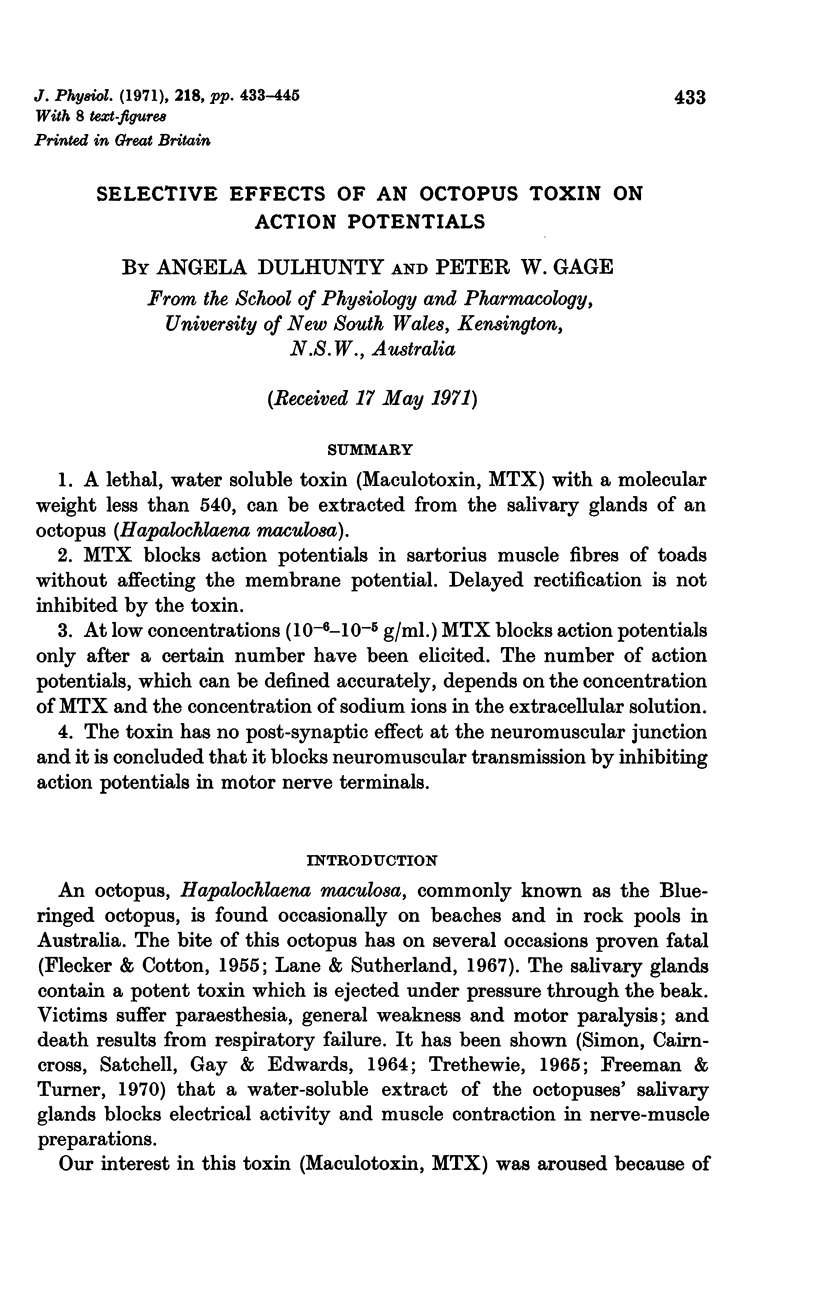Abstract
1. A lethal, water soluble toxin (Maculotoxin, MTX) with a molecular weight less than 540, can be extracted from the salivary glands of an octopus (Hapalochlaena maculosa).
2. MTX blocks action potentials in sartorius muscle fibres of toads without affecting the membrane potential. Delayed rectification is not inhibited by the toxin.
3. At low concentrations (10-6-10-5 g/ml.) MTX blocks action potentials only after a certain number have been elicited. The number of action potentials, which can be defined accurately, depends on the concentration of MTX and the concentration of sodium ions in the extracellular solution.
4. The toxin has no post-synaptic effect at the neuromuscular junction and it is concluded that it blocks neuromuscular transmission by inhibiting action potentials in motor nerve terminals.
Full text
PDF












Selected References
These references are in PubMed. This may not be the complete list of references from this article.
- ARMSTRONG C. M., BINSTOCK L. THE EFFECTS OF SEVERAL ALCOHOLS ON THE PROPERTIES OF THE SQUID GIANT AXON. J Gen Physiol. 1964 Nov;48:265–277. doi: 10.1085/jgp.48.2.265. [DOI] [PMC free article] [PubMed] [Google Scholar]
- DEL CASTILLO J., KATZ B. Quantal components of the end-plate potential. J Physiol. 1954 Jun 28;124(3):560–573. doi: 10.1113/jphysiol.1954.sp005129. [DOI] [PMC free article] [PubMed] [Google Scholar]
- Eisenberg R. S., Gage P. W. Ionic conductances of the surface and transverse tubular membranes of frog sartorius fibers. J Gen Physiol. 1969 Mar;53(3):279–297. doi: 10.1085/jgp.53.3.279. [DOI] [PMC free article] [PubMed] [Google Scholar]
- FATT P., KATZ B. An analysis of the end-plate potential recorded with an intracellular electrode. J Physiol. 1951 Nov 28;115(3):320–370. doi: 10.1113/jphysiol.1951.sp004675. [DOI] [PMC free article] [PubMed] [Google Scholar]
- FLECKER H., COTTON B. C. Fatal bite from octopus. Med J Aust. 1955 Aug 27;42(9):329–331. [PubMed] [Google Scholar]
- Freeman SE TURNER R. J. Maculotoxin, a potent toxin secreted by Octopus maculosus Hoyle. Toxicol Appl Pharmacol. 1970 May;16(3):681–690. doi: 10.1016/0041-008x(70)90073-6. [DOI] [PubMed] [Google Scholar]
- Gage P. W., Eisenberg R. S. Action potentials, afterpotentials, and excitation-contraction coupling in frog sartorius fibers without transverse tubules. J Gen Physiol. 1969 Mar;53(3):298–310. doi: 10.1085/jgp.53.3.298. [DOI] [PMC free article] [PubMed] [Google Scholar]
- Gage P. W., Eisenberg R. S. Capacitance of the surface and transverse tubular membrane of frog sartorius muscle fibers. J Gen Physiol. 1969 Mar;53(3):265–278. doi: 10.1085/jgp.53.3.265. [DOI] [PMC free article] [PubMed] [Google Scholar]
- Gage P. W., Quastel D. M. Competition between sodium and calcium ions in transmitter release at mammalian neuromuscular junctions. J Physiol. 1966 Jul;185(1):95–123. doi: 10.1113/jphysiol.1966.sp007974. [DOI] [PMC free article] [PubMed] [Google Scholar]
- Kao C. Y. Tetrodotoxin, saxitoxin and their significance in the study of excitation phenomena. Pharmacol Rev. 1966 Jun;18(2):997–1049. [PubMed] [Google Scholar]
- LILEY A. W. The effects of presynaptic polarization on the spontaneous activity at the mammalian neuromuscular junction. J Physiol. 1956 Nov 28;134(2):427–443. doi: 10.1113/jphysiol.1956.sp005655. [DOI] [PMC free article] [PubMed] [Google Scholar]
- MARTIN A. R. A further study of the statistical composition on the end-plate potential. J Physiol. 1955 Oct 28;130(1):114–122. doi: 10.1113/jphysiol.1955.sp005397. [DOI] [PMC free article] [PubMed] [Google Scholar]
- MOORE J. W., ULBRICHT W., TAKATA M. EFFECT OF ETHANOL ON THE SODIUM AND POTASSIUM CONDUCTANCES OF THE SQUID AXON MEMBRANE. J Gen Physiol. 1964 Nov;48:279–295. doi: 10.1085/jgp.48.2.279. [DOI] [PMC free article] [PubMed] [Google Scholar]
- NARAHASHI T., MOORE J. W., SCOTT W. R. TETRODOTOXIN BLOCKAGE OF SODIUM CONDUCTANCE INCREASE IN LOBSTER GIANT AXONS. J Gen Physiol. 1964 May;47:965–974. doi: 10.1085/jgp.47.5.965. [DOI] [PMC free article] [PubMed] [Google Scholar]
- Narahashi T., Anderson N. C., Moore J. W. Tetrodotoxin does not block excitation from inside the nerve membrane. Science. 1966 Aug 12;153(3737):765–767. doi: 10.1126/science.153.3737.765. [DOI] [PubMed] [Google Scholar]
- SHANES A. M., FREYGANG W. H., GRUNDFEST H., AMATNIEK E. Anesthetic and calcium action in the voltage-clamped squid giant axon. J Gen Physiol. 1959 Mar 20;42(4):793–802. doi: 10.1085/jgp.42.4.793. [DOI] [PMC free article] [PubMed] [Google Scholar]
- SIMON S. E., CAIRNCROSS K. D., SATCHELL D. G., GAY W. S., EDWARDS S. THE TOXICITY OF OCTOPUS MACULOSUS HOYLE VENOM. Arch Int Pharmacodyn Ther. 1964 Jun 1;149:318–329. [PubMed] [Google Scholar]
- Sutherland S. K., Broad A. J., Lane W. R. Octopus neurotoxins: low molecular weight non-immunogenic toxins present in the saliva of the blue-ringed octopus. Pediatr Clin North Am. 1970 Aug;17(3):249–250. doi: 10.1016/0041-0101(70)90210-2. [DOI] [PubMed] [Google Scholar]
- TAYLOR R. E. Effect of procaine on electrical properties of squid axon membrane. Am J Physiol. 1959 May;196(5):1071–1078. doi: 10.1152/ajplegacy.1959.196.5.1071. [DOI] [PubMed] [Google Scholar]
- Trethewie E. R. Pharmacological effects of the venom of the common octopus Hapalochlaena maculosa. Toxicon. 1965 Sep;3(1):55–59. doi: 10.1016/0041-0101(65)90068-1. [DOI] [PubMed] [Google Scholar]


